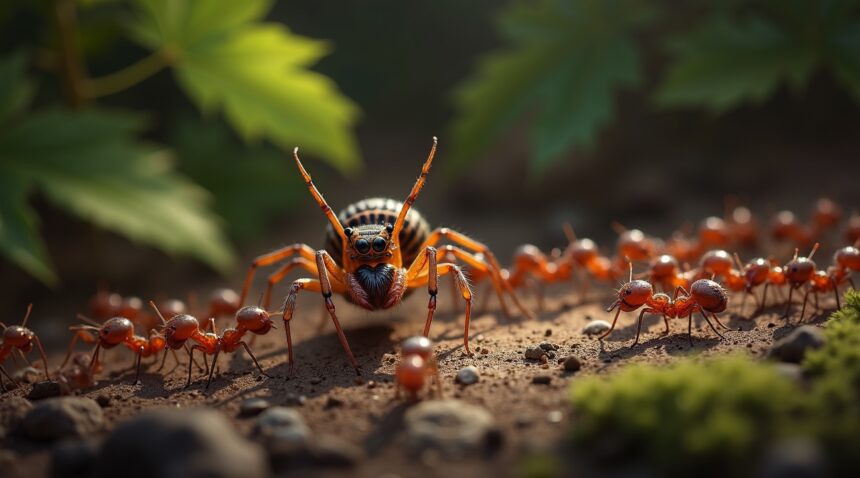Myrmecomorphy showcases nature’s incredible capacity to develop complex deception strategies. Spiders transform into convincing ant replicas through visual, chemical, and behavioral adaptations that have evolved independently over 70 times across different species.
This evolutionary strategy is remarkably effective. Research confirms that ant-mimicking spiders benefit from real protection against predators, who typically avoid ants due to their defensive chemicals and naturally aggressive behavior.
Key Takeaways
- Multifaceted Mimicry: Spiders employ forms of mimicry such as Batesian mimicry for protection, aggressive mimicry to aid hunting, and Wasmannian mimicry for infiltrating ant colonies.
- Beyond Appearance: The mimicry goes beyond visuals to include pheromone-based chemical mimicry, ant-like movement, and textures that deceive both predators and ants.
- Scientific Validation: Experiments show birds avoid both ants and their spider mimics after bad encounters, indicating these adaptations significantly increase spider survival.
- Species Examples: Notable cases include Myrmarachne marshalli with elongated chelicerae, Synageles venator which sacrifices reproductive output for survival, and Phrurolithus festivus, which demonstrates effective but imperfect mimicry.
- Ancient Origins: The evolutionary strategy dates back to the mid-Cretaceous period and involves more than 13 spider families, all exploiting predator visual perception to survive.
Further Exploration
If you’re interested in learning more about the fascinating world of mimicry and evolutionary strategies, visit the Wikipedia entry on Myrmecomorphy.
Myrmecomorphy: Masters of Disguise
Myrmecomorphy represents one of nature’s most sophisticated deception strategies, where spiders transform themselves into convincing ant replicas to survive in a world full of predators. This remarkable form of mimicry has evolved independently over 70 times across different species, demonstrating just how effective ant impersonation can be for spider survival.
The Evolutionary Success of Ant Mimicry
Spiders have discovered that ants make perfect disguise models for several compelling reasons. Ants possess natural defenses that make them unappealing targets – their aggressive nature, ability to deliver painful bites or stings, and often bitter taste create a powerful deterrent effect. Visual predators like birds quickly learn to avoid these feisty insects, making ant mimicry an excellent strategy for vulnerable spiders.
The fossil record reveals that ant mimics first appeared during the mid-Cretaceous era, indicating this survival strategy has been refined over millions of years. At least 13 spider families have independently developed myrmecomorphic traits, with the Salticidae family (jumping spiders) being particularly renowned for their convincing ant impersonations. These spiders don’t just look like ants – they’ve mastered the art of moving, behaving, and even smelling like their models.
Beyond Visual Deception
While visual mimicry forms the foundation of myrmecomorphy, successful ant-mimicking spiders employ multiple layers of deception.
- Chemical mimicry: Many species have evolved to produce or acquire the same pheromones that ants use for communication. This chemical camouflage helps them blend seamlessly into ant colonies or avoid detection by predators that rely on scent.
- Aggressive mimicry: Some spider species use their ant-like appearance to get close enough to actual ants to prey upon them.
- Batesian mimicry: Harmless spiders gain protection by resembling dangerous or unpalatable ant species.
The abundance of ants in most ecosystems makes this strategy particularly viable – predators encounter real ants so frequently that they generalize their avoidance behavior to include convincing mimics.
Modern research continues to uncover new examples of myrmecomorphic spiders, much like scientists discovering undiscovered species in remote locations. Each discovery adds another piece to our understanding of how evolutionary pressure shapes these incredible adaptations. The success of myrmecomorphy demonstrates that in nature’s game of survival, sometimes the best defense isn’t fighting back – it’s becoming someone else entirely.
The precision required for effective ant mimicry extends beyond simple appearance. Successful mimics must:
- Coordinate their leg movements to create the illusion of antennae
- Adjust their gait to match ant locomotion patterns
- Modify their body posture to eliminate the obvious waist constriction that distinguishes spiders from their six-legged models
This level of adaptation showcases the remarkable plasticity of evolutionary processes when survival depends on perfect deception.
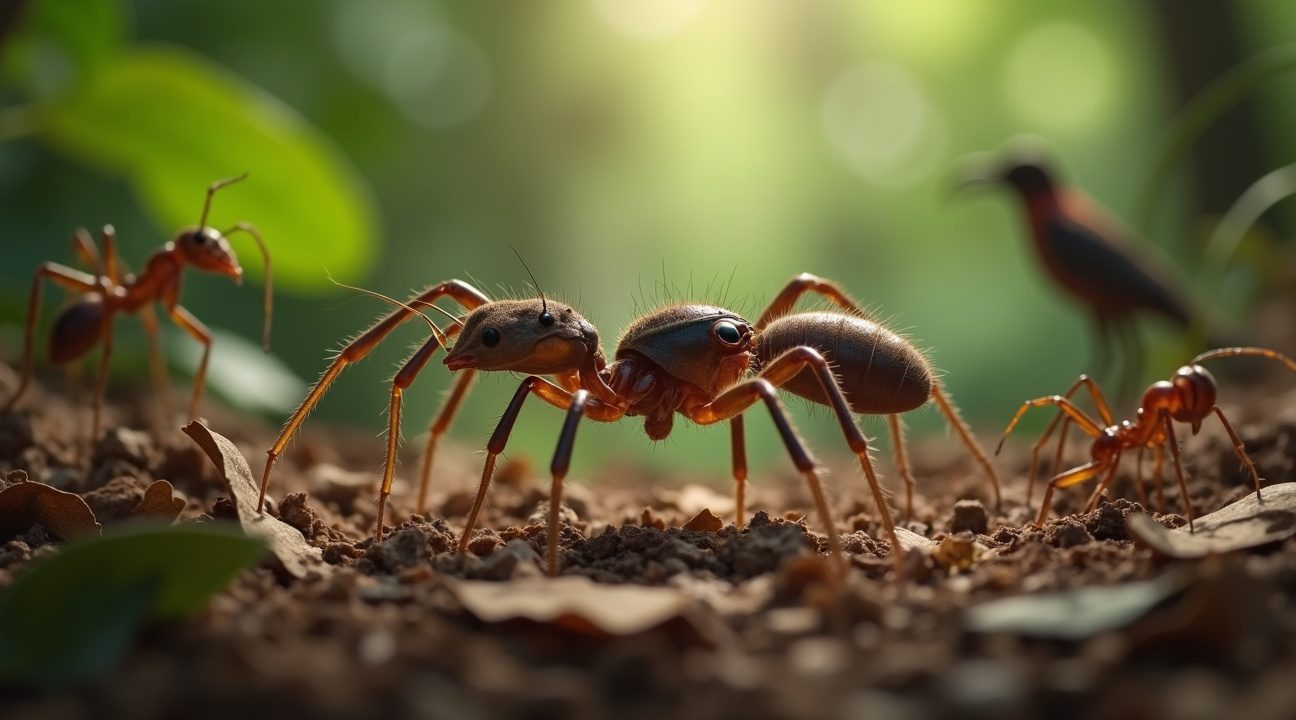
Proven Protection: Scientific Evidence Shows Ant Mimicry Actually Works
Research demonstrates that ant mimicry provides genuine protection for spiders through carefully controlled experiments with avian predators. Studies involving great tits reveal fascinating patterns of predator behavior that confirm the effectiveness of myrmecomorphic deception.
Laboratory Evidence of Predator Avoidance
Experimental trials show great tits consistently avoid both real ants and ant-mimicking spiders after experiencing negative encounters. Birds attacked ants significantly less frequently than larval crickets, indicating their learned aversion stems from previous exposure to defensive chemicals like formic acid. This behavioral pattern extends to ant-mimicking spiders, proving that visual similarity alone can trigger predator avoidance responses.
The spider Phrurolithus festivus demonstrates particularly compelling evidence of successful Batesian mimicry. During controlled experiments, this species faced attacks far less often than non-mimicking spiders and received treatment nearly identical to genuine ants. However, when predators did attack, they consumed the spiders more readily than actual ants, revealing the absence of chemical defenses in the mimics.
Understanding the Mechanisms Behind Protection
Avian experimental trials illuminate how predators learn to associate visual cues with unpleasant experiences. Great tits develop strong aversions after encountering ants and their defensive signals, particularly the painful effects of formic acid ingestion. This learned behavior creates a protective umbrella that benefits ant-mimicking spiders through no effort of their own.
The research confirms that defensive mimicry operates through visual deception rather than chemical protection. While genuine ants possess formic acid and other deterrent compounds, mimicking spiders rely entirely on their convincing appearance. Birds that have learned to avoid ants transfer this caution to visually similar spiders, even though the spiders lack any chemical defenses. This phenomenon exemplifies classic Batesian mimicry, where harmless species benefit by resembling dangerous or unpalatable models.
Scientists have documented how predator avoidance behaviors persist over time, suggesting that ant mimicry provides consistent protection in natural environments. The effectiveness of this strategy depends on predators maintaining their learned associations between ant-like appearance and negative experiences, creating long-term benefits for color-changing organisms that employ similar deceptive tactics.
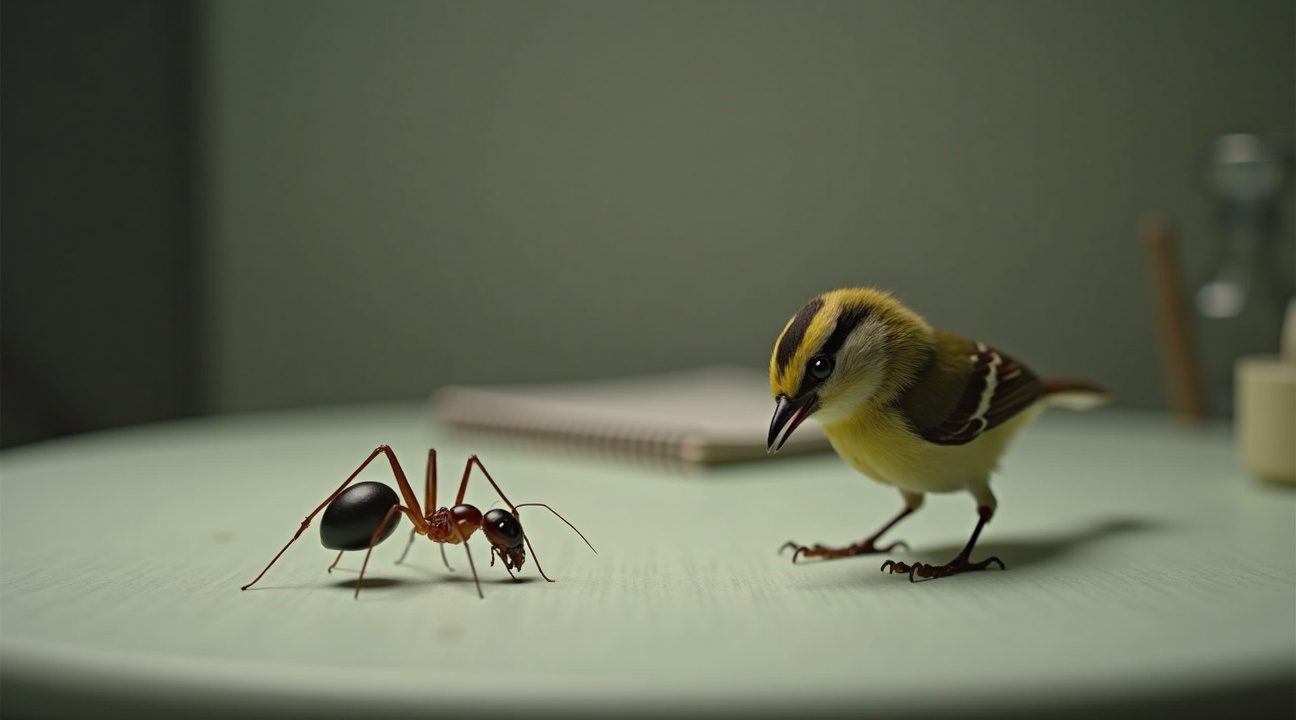
Meet the Spider Imposters: Real Examples of Ant Mimicking Species
Spider imposters have perfected the art of deception through millions of years of evolution, and several species demonstrate remarkable ant mimicry abilities. These master disguise artists showcase how effective myrmecomorphy can be as a survival strategy.
Jumping Spider Champions of Mimicry
Myrmarachne marshalli stands out as one of the most convincing ant mimics in the spider world. Males display notably elongated chelicerae that enhance their ant-like appearance, while females achieve an even more striking resemblance to their ant models. This species demonstrates how sexual dimorphism can play different roles in mimetic strategies.
Synageles venator, discovered in Germany, represents another fascinating example of ant mimicry effectiveness. This species lays remarkably few eggs compared to other spiders, yet their survival rates remain high due to their exceptional mimicry skills. The reduced reproductive output suggests that investing energy in perfect disguise pays off more than producing numerous vulnerable offspring.
Ground-Level Masters of Deception
Micaria species excel at ground-level ant mimicry, combining both physical appearance and behavioral adaptations. These small ground spiders have mastered ant-like movement patterns and body shapes so effectively that casual observers often can’t distinguish them from actual ants at first glance. Their success lies in matching both the visual and kinetic elements of ant behavior.
Phrurolithus festivus provides compelling evidence for the effectiveness of even imperfect mimicry. Research testing this species revealed that despite being an imperfect mimic, it still receives significant protection from bird predators. This demonstrates classic Batesian mimicry in action, where resembling a dangerous or unpalatable model species provides survival advantages even when the resemblance isn’t flawless.
Each of these species has evolved unique approaches to ant mimicry, from the morphological adaptations of Myrmarachne marshalli to the behavioral precision of Micaria species. Similar to how octopuses change colors for deception, these spiders have developed sophisticated defensive strategies. The success of these mimetic spiders proves that evolution rewards creative survival solutions, and their continued existence demonstrates that fooling predators through appearance and behavior remains one of nature’s most effective defense mechanisms.
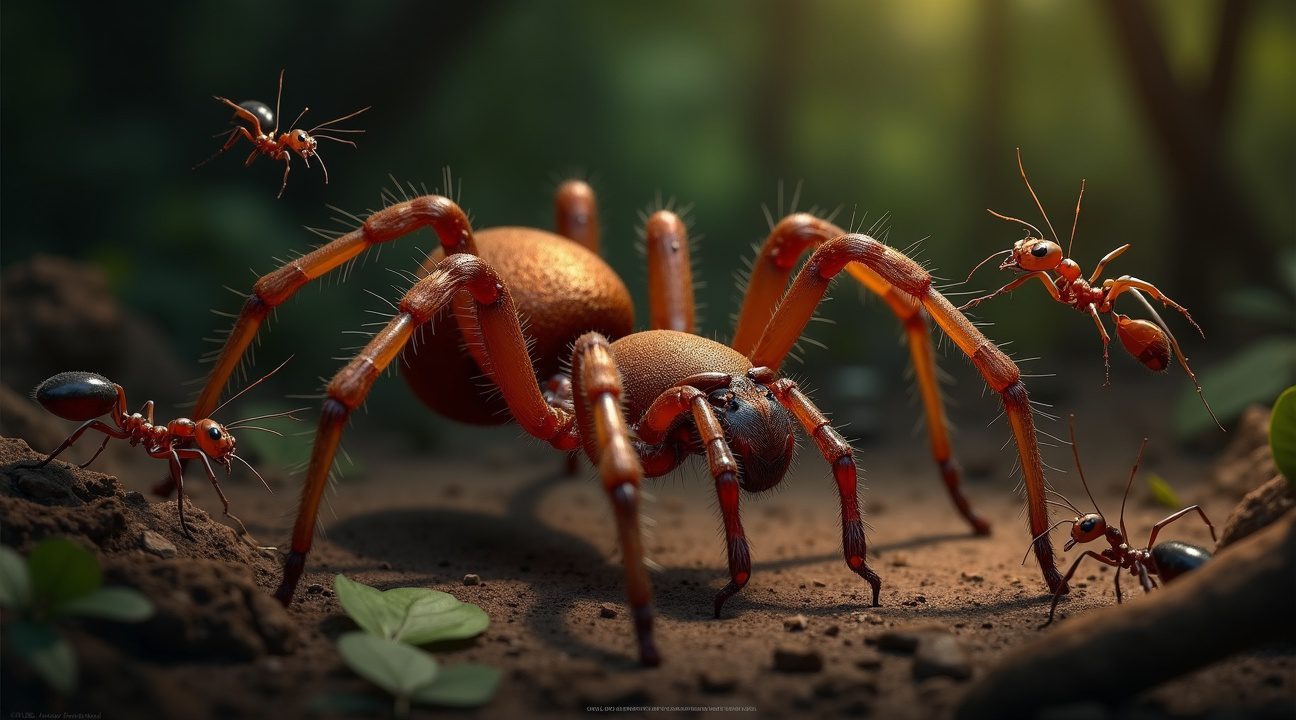
From Defense to Attack: Different Types of Ant Mimicry Strategies
Spider ant mimicry exists as a complex survival strategy that branches into several distinct forms, each serving different purposes in the predator-prey dynamic. These remarkable arachnids employ various approaches to exploit the protective benefits of resembling their formidable six-legged counterparts.
Batesian Mimicry: The Art of Protective Deception
Batesian mimicry represents the most straightforward form of ant mimicry, where harmless spiders benefit from resembling dangerous or unpalatable ants. This strategy functions as a sophisticated shield against predators who’ve learned to avoid certain ant species. The spider gains protection without possessing the actual defensive capabilities of its model.
This defensive strategy proves particularly effective because many predators develop strong aversions to ants after experiencing their painful bites or chemical defenses. Birds, for instance, quickly learn to avoid certain ant species and subsequently reject ant-mimicking spiders. The visual deception works so well that even experienced naturalists sometimes mistake these spiders for genuine ants at first glance.
Spider species employing Batesian mimicry often enhance their disguise through behavioral modifications. They adopt ant-like movements, hold their front legs up to simulate antennae, and even travel in single-file formations. Some species take this deception further by positioning themselves among actual ant trails, making detection nearly impossible for casual observers.
Aggressive Mimicry and Myrmecophily: Infiltration Tactics
Aggressive mimicry flips the protective strategy into an offensive weapon. Here, spiders use their ant-like appearance to approach unsuspecting prey or infiltrate ant colonies for hunting opportunities. This strategy requires even more precise mimicry since the spider must fool not just distant predators but also close-up prey and sometimes the ants themselves.
These predatory mimics often target ant eggs and larvae within colonies, representing a high-risk, high-reward hunting strategy. The spider must perfect its disguise to avoid detection by worker ants who would quickly mobilize to defend their colony. Success depends on mastering multiple deception layers including visual appearance, movement patterns, and sometimes chemical signals.
Myrmecophily takes ant association to its most advanced level. These spiders don’t simply mimic ants visually but integrate themselves into ant societies through multiple sensory channels. Color adaptation abilities in some species parallel this sophisticated mimicry, though spiders achieve their deception through different mechanisms.
Myrmecophilous spiders often develop chemical mimicry alongside their visual disguise. They may acquire ant colony odors through direct contact or produce similar chemical compounds themselves. This chemical camouflage proves crucial since ants rely heavily on scent recognition for colony membership identification.
Wasmannian mimicry represents another specialized form where spiders not only live among ants but may even receive care from them. These relationships can become so integrated that the spiders essentially function as colony members, receiving food and protection while contributing little to colony welfare.
Tactile signals also play important roles in these complex relationships. Some myrmecophilous spiders learn to communicate through touch patterns that ants recognize, further cementing their acceptance within the colony structure. This multi-modal deception requires remarkable adaptability and represents one of nature’s most sophisticated infiltration strategies.
The success of these various mimicry strategies demonstrates the evolutionary pressure that ants exert on other arthropod communities. Intelligence and adaptation drive these remarkable transformations, showing how survival pressures shape extraordinary biological solutions across different species.
Beyond Looks: The Complex World of Chemical and Behavioral Mimicry
Physical resemblance represents just the beginning of spider deception strategies. Ant-mimicking spiders have developed sophisticated methods that extend far beyond visual tricks, incorporating chemical signals, behavioral patterns, and even tactile elements to perfect their disguise.
Chemical Deception Through Pheromonal Mimicry
Chemical mimicry stands as one of the most advanced forms of deception in the spider world. Ant-mimicking spiders produce pheromones that closely match those of their target ant species, allowing them to infiltrate colonies without triggering alarm responses. This Wasmannian mimicry enables spiders to move freely within ant nests, accessing both shelter and prey opportunities that would otherwise remain impossible to exploit.
The chemical signals function as social releasers, effectively communicating “friend” rather than “foe” to ant colony members. Spiders that master this technique can remain undetected for extended periods, sometimes even receiving care and protection from the very ants they’re deceiving. This level of chemical sophistication demonstrates how evolution shapes complex behaviors across different species.
Behavioral and Tactile Elements of Perfect Mimicry
Behavioral mimicry complements chemical deception through precise movement patterns. These spiders adopt ant-like gaits, antenna-waving motions using their front legs, and even grooming behaviors that mirror their models. Some species have perfected the characteristic three-part body language of ants, moving in ways that emphasize their apparent head, thorax, and abdomen divisions.
Tactile mimicry adds another layer of sophistication through surface microstructure replication. Ant colonies rely heavily on physical inspection during encounters, using their antennae to examine surface textures and chemical signatures. Successful spider mimics have evolved body surfaces that feel remarkably similar to genuine ant exoskeletons, complete with appropriate textures and chemical coatings.
The combination of these mimicry types creates nearly perfect deceptions. Spiders that employ multiple mimicry strategies simultaneously achieve success rates that approach those of genuine social insects. Much like how other creatures use sophisticated disguises, these arachnids demonstrate that survival often depends on mastering multiple forms of deception rather than relying on any single strategy.
This multi-layered approach to mimicry represents millions of years of evolutionary refinement. Each element—chemical, behavioral, and tactile—works in concert to create deceptions so complete that even trained researchers sometimes struggle to distinguish the mimics from their models during field observations.
The Bigger Picture: Evolution and Ecological Impact of Spider Ant Mimicry
Spider ant mimicry represents one of nature’s most fascinating evolutionary strategies, driven primarily by predator avoidance rather than any attempt to fool the ants themselves. I find it remarkable that this sophisticated deception evolved specifically to exploit the visual systems of predators, particularly since most ants are nearly blind and rely heavily on chemical communication.
The evolutionary pressure behind myrmecomorphy stems from visually oriented predators who have learned to avoid ants as prey. Birds, jumping spiders, and other visual hunters often steer clear of ants due to their defensive chemicals, aggressive behavior, or simply their unpalatable taste. Spiders that evolved to look like ants gained a significant survival advantage by tapping into this learned avoidance behavior.
Predator Vision Shapes Mimicry Strategy
Different types of predators see the world in dramatically different ways, leading to distinct evolutionary paths for ant-mimicking spiders. Avian predators possess highly sophisticated color vision and can detect subtle differences in movement patterns, pushing some spider species to develop incredibly precise behavioral mimicry alongside their physical resemblance. These spiders don’t just look like ants—they move like them too, often waving their front legs to simulate antennae movements.
Invertebrate predators, however, operate with different visual systems entirely. Jumping spiders and mantises focus more on movement patterns and basic shape recognition. This difference has led to varied evolutionary strategies among myrmecomorphic spiders, with some species optimizing their disguise for specific predator types in their environment.
The ecological impact of spider ant mimicry extends far beyond simple predator-prey relationships. Since the initial documentation of 1,177 myrmecophilous species in 1894, researchers have discovered countless additional examples, revealing the extensive reach of this evolutionary strategy across different ecosystems. Just as octopus color changes demonstrate sophisticated animal deception, spider ant mimicry shows how visual signals can evolve to exploit predator behavior patterns.
This adaptive radiation has created a complex web of ecological interactions. Ant-mimicking spiders often occupy similar microhabitats to their models, creating competition for resources while simultaneously benefiting from the protective umbrella of ant colonies. Some species have become so specialized that they’ve essentially become ecological proxies for ants in certain niches, affecting prey populations and ecosystem dynamics in ways that mirror true ant impacts.
The evolutionary arms race continues today, with predators potentially developing better recognition abilities while spiders refine their mimetic strategies. This ongoing process demonstrates how evolutionary intelligence manifests through morphological and behavioral adaptations rather than cognitive complexity alone.
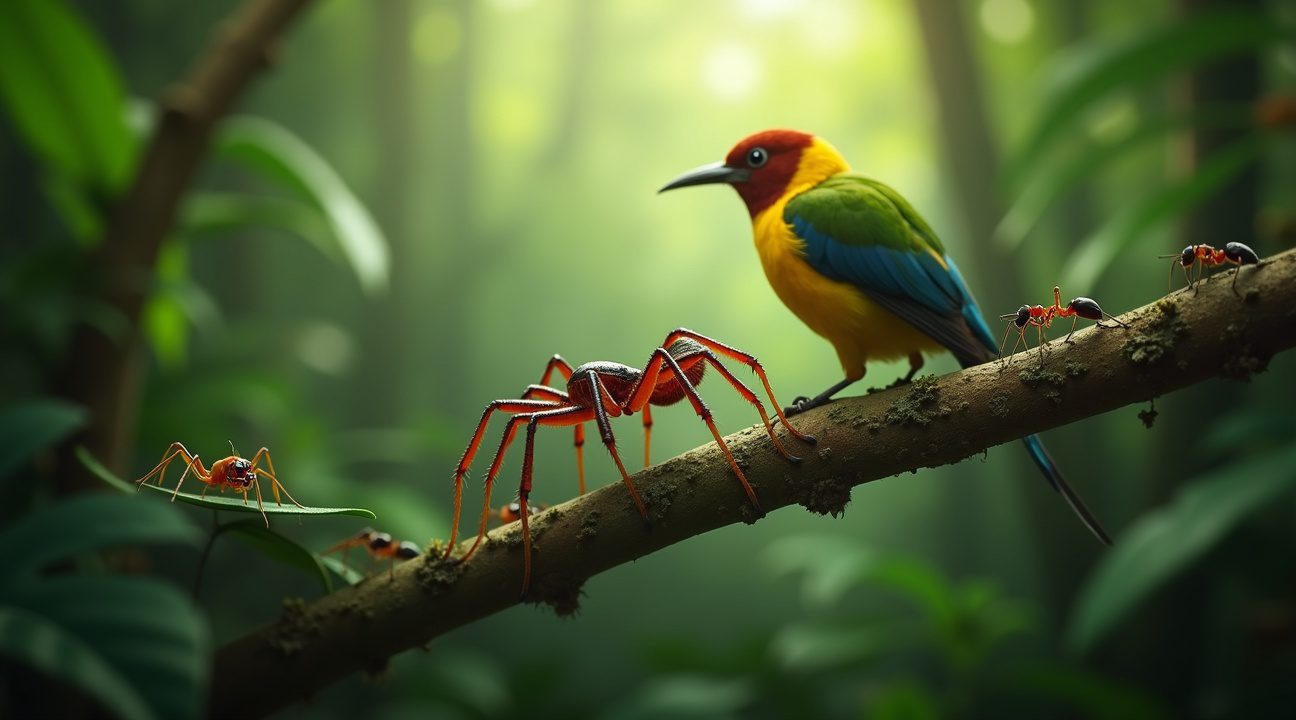
Sources:
Wikipedia, “Ant mimicry”
Wildmacro, “Ant mimicry by ant-mimicking jumping spiders”
Nature, “Predation by avian predators may have initiated the evolution of myrmecomorphy in spiders”
PubMed Central, “Aggressive use of Batesian mimicry by an ant-like jumping spider”

